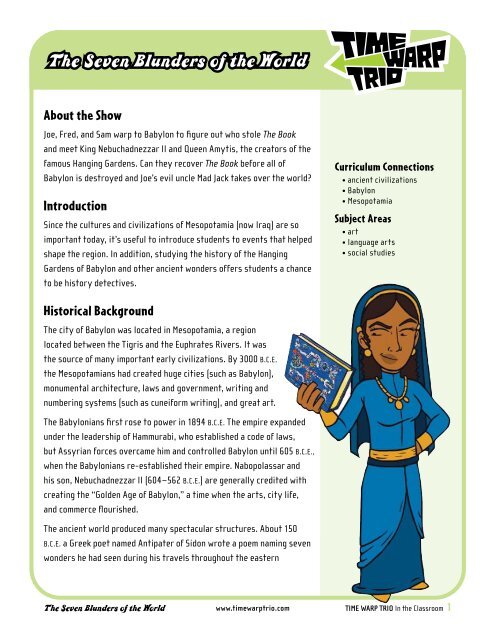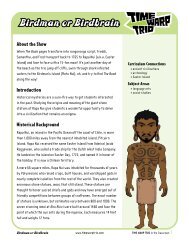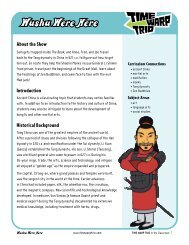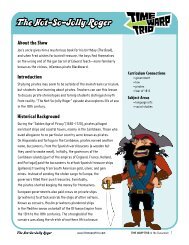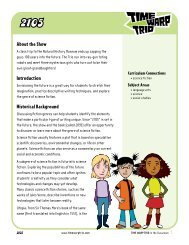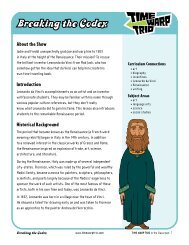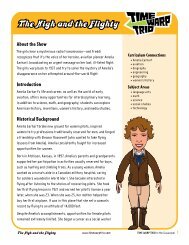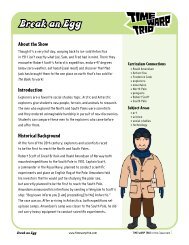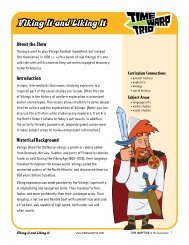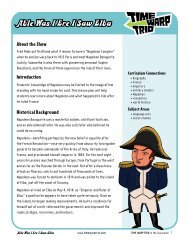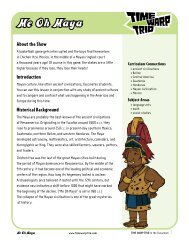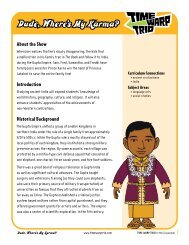The Seven Blunders of the World - Time Warp Trio
The Seven Blunders of the World - Time Warp Trio
The Seven Blunders of the World - Time Warp Trio
Create successful ePaper yourself
Turn your PDF publications into a flip-book with our unique Google optimized e-Paper software.
<strong>The</strong> <strong>Seven</strong> <strong>Blunders</strong> <strong>of</strong> <strong>the</strong> <strong>World</strong><br />
About <strong>the</strong> Show<br />
Joe, Fred, and Sam warp to Babylon to figure out who stole <strong>The</strong> Book<br />
and meet King Nebuchadnezzar II and Queen Amytis, <strong>the</strong> creators <strong>of</strong> <strong>the</strong><br />
famous Hanging Gardens. Can <strong>the</strong>y recover <strong>The</strong> Book before all <strong>of</strong><br />
Babylon is destroyed and Joe’s evil uncle Mad Jack takes over <strong>the</strong> world?<br />
Introduction<br />
Since <strong>the</strong> cultures and civilizations <strong>of</strong> Mesopotamia (now Iraq) are so<br />
important today, it’s useful to introduce students to events that helped<br />
shape <strong>the</strong> region. In addition, studying <strong>the</strong> history <strong>of</strong> <strong>the</strong> Hanging<br />
Gardens <strong>of</strong> Babylon and o<strong>the</strong>r ancient wonders <strong>of</strong>fers students a chance<br />
to be history detectives.<br />
Historical Background<br />
<strong>The</strong> city <strong>of</strong> Babylon was located in Mesopotamia, a region<br />
located between <strong>the</strong> Tigris and <strong>the</strong> Euphrates Rivers. It was<br />
<strong>the</strong> source <strong>of</strong> many important early civilizations. By 3000 B.C.E.<br />
<strong>the</strong> Mesopotamians had created huge cities (such as Babylon),<br />
monumental architecture, laws and government, writing and<br />
numbering systems (such as cuneiform writing), and great art.<br />
<strong>The</strong> Babylonians first rose to power in 1894 B.C.E. <strong>The</strong> empire expanded<br />
under <strong>the</strong> leadership <strong>of</strong> Hammurabi, who established a code <strong>of</strong> laws,<br />
but Assyrian forces overcame him and controlled Babylon until 605 B.C.E.,<br />
when <strong>the</strong> Babylonians re-established <strong>the</strong>ir empire. Nabopolassar and<br />
his son, Nebuchadnezzar II (604–562 B.C.E.) are generally credited with<br />
creating <strong>the</strong> “Golden Age <strong>of</strong> Babylon,” a time when <strong>the</strong> arts, city life,<br />
and commerce flourished.<br />
<strong>The</strong> ancient world produced many spectacular structures. About 150<br />
B.C.E. a Greek poet named Antipater <strong>of</strong> Sidon wrote a poem naming seven<br />
wonders he had seen during his travels throughout <strong>the</strong> eastern<br />
<strong>The</strong> <strong>Seven</strong> <strong>Blunders</strong> <strong>of</strong> <strong>the</strong> <strong>World</strong><br />
www.timewarptrio.com<br />
Curriculum Connections<br />
• ancient civilizations<br />
• Babylon<br />
• Mesopotamia<br />
Subject Areas<br />
• art<br />
• language arts<br />
• social studies<br />
<strong>Time</strong> <strong>Warp</strong> <strong>Trio</strong> In <strong>the</strong> Classroom
<strong>The</strong> <strong>Seven</strong> <strong>Blunders</strong> <strong>of</strong> <strong>the</strong> <strong>World</strong><br />
Historical Background continued<br />
Mediterranean world. In <strong>the</strong> 16th century, Dutch artist Maerten van Heemskerck imagined what <strong>the</strong>se<br />
legendary monuments looked like in a series <strong>of</strong> engravings. <strong>The</strong>se pictures helped to establish what is<br />
now a definitive list. From <strong>the</strong> oldest to <strong>the</strong> most recent, <strong>the</strong>y were:<br />
1. Great Pyramid at Giza<br />
2. <strong>The</strong> Hanging Gardens <strong>of</strong> Babylon<br />
3. Temple <strong>of</strong> Artemis at Ephesus<br />
4. Statue <strong>of</strong> Zeus at Olympia<br />
<strong>The</strong> <strong>Seven</strong> <strong>Blunders</strong> <strong>of</strong> <strong>the</strong> <strong>World</strong><br />
5. Mausoleum at Halicarnassus<br />
6. Colossus <strong>of</strong> Rhodes<br />
7. Pharos <strong>of</strong> Alexandra<br />
According to legend, King Nebuchadrezzar II built <strong>the</strong> Hanging Gardens to please his wife Amytis. She<br />
missed her green and mountainous homeland in nor<strong>the</strong>rn Iraq while living in <strong>the</strong> hot, dry, city<br />
<strong>of</strong> Babylon.<br />
<strong>The</strong> gardens were made up <strong>of</strong> a pyramid-like construction <strong>of</strong> terraces that rested on stone columns so<br />
<strong>the</strong> royals could stroll about and not be bo<strong>the</strong>red by <strong>the</strong> work <strong>of</strong> those who tended <strong>the</strong> five-tier gardens.<br />
<strong>The</strong> gardens were irrigated by a great water wheel bringing water from <strong>the</strong> Euphrates River.<br />
When Mesopotamia was conquered by Persia (now Iran) and later by Greece and Rome, much <strong>of</strong> its culture<br />
continued to influence people not only in its native lands, but in Europe and <strong>the</strong> West. Our 360-degree circle,<br />
12-hour clock, and 60-minute hour are derived from <strong>the</strong> ancient Mesopotamian number system, and much<br />
<strong>of</strong> Hammurabi’s code (written to “cause justice to prevail in <strong>the</strong> land, to destroy <strong>the</strong> wicked and evil, that<br />
<strong>the</strong> strong may not oppress <strong>the</strong> weak”) can be seen in our modern legal system.<br />
Want students to get even more<br />
excited about history?<br />
Check out <strong>the</strong> ancient Babylon adventure for kids at<br />
www.timewarptrio.com/adventures/babylon/<br />
Put It Back, Jack! and o<strong>the</strong>r interactive games to play.<br />
Plentifax 487—<strong>the</strong> ultimate time traveler’s guide—gives facts<br />
about <strong>the</strong> way Babylonians lived, worked, and more!<br />
Cool Books that kids will love.<br />
www.timewarptrio.com<br />
<strong>Time</strong> <strong>Warp</strong> <strong>Trio</strong> In <strong>the</strong> Classroom
Activity<br />
1<br />
Name Challenge<br />
as Fred, Joe, and Sam learn in <strong>the</strong> show “<strong>Seven</strong> <strong>Blunders</strong> <strong>of</strong><br />
<strong>the</strong> <strong>World</strong>,” cuneiform was one <strong>of</strong> <strong>the</strong> earliest writing systems.<br />
it originated in a region called Sumer around 3000 B.C.e. originally<br />
a way to keep records, cuneiform—pictographs and <strong>the</strong>n a<br />
combination <strong>of</strong> symbols on clay tablets—was soon used for many<br />
o<strong>the</strong>r purposes, such as writing down laws, stories, recipes, etc.<br />
By 2500 B.C.e., schools for scribes began to emerge. <strong>The</strong> students<br />
were from <strong>the</strong> wealthy classes and subsequently received<br />
positions in <strong>the</strong> palace, <strong>the</strong> temples, <strong>the</strong> military, and o<strong>the</strong>r<br />
government departments. Since reading and writing were such<br />
rare skills, such an education could pave <strong>the</strong> way for a career<br />
as a political or religious leader. Cuneiform was written on moist<br />
clay tablets with a triangular shaped stick.<br />
This activity invites students to research and learn how to write<br />
<strong>the</strong>ir names in different languages.<br />
Instructions<br />
. If students in your class come from o<strong>the</strong>r cultures, ask <strong>the</strong>m to write<br />
<strong>the</strong>ir names in <strong>the</strong>ir native language. Compare <strong>the</strong> alphabet or writing<br />
system <strong>the</strong>y use to <strong>the</strong> English alphabet.<br />
. Give students a brief introduction to cuneiform writing and show students<br />
an example. (See Resources)<br />
. Have students visit www.upennmuseum.com/cuneiform.cgi to see how<br />
to write <strong>the</strong>ir names in cuneiform. Have <strong>the</strong>m copy <strong>the</strong>ir names onto strips<br />
<strong>of</strong> poster board and post <strong>the</strong>m in <strong>the</strong> classroom.<br />
4. Have students visit omniglot.com/links/yournamein. Have <strong>the</strong>m translate<br />
<strong>the</strong>ir name into one <strong>of</strong> <strong>the</strong> languages or writing systems presented <strong>the</strong>re<br />
(Arabic, Braille, Chinese, Greek, Hawaiian, Hebrew, hieroglyphs, Inktitut,<br />
Japanese, Korean, Latin, Mayan, runes, Tagalog, or Thai).<br />
5. Using a world map, have students locate <strong>the</strong> appropriate country or<br />
region that corresponds to <strong>the</strong> language <strong>the</strong>y chose and place <strong>the</strong>ir name<br />
on <strong>the</strong> map.<br />
<strong>The</strong> <strong>Seven</strong> <strong>Blunders</strong> <strong>of</strong> <strong>the</strong> <strong>World</strong> www.timewarptrio.com<br />
Objectives<br />
• to enhance multicultural<br />
understanding<br />
• to compare symbol systems<br />
Materials<br />
• world map<br />
• writing supplies<br />
Curriculum Standards<br />
• NCSS<br />
Culture: Students will describe<br />
instances in which language,<br />
art, music, belief systems,<br />
and o<strong>the</strong>r cultural elements can<br />
facilitate understanding or<br />
cause misunderstanding.<br />
• NCTe/ira<br />
Students develop an understanding<br />
<strong>of</strong> and respect for diversity<br />
in language use, patterns, and<br />
dialects across cultures, ethnic<br />
groups, geographic regions,<br />
and social roles.<br />
<strong>Time</strong> <strong>Warp</strong> <strong>Trio</strong> In <strong>the</strong> Classroom
Activity<br />
2<br />
Wonders <strong>of</strong> <strong>the</strong> Ancient <strong>World</strong><br />
Students learn about <strong>the</strong> <strong>Seven</strong> Wonders <strong>of</strong> <strong>the</strong> ancient <strong>World</strong><br />
and present <strong>the</strong>ir information to <strong>the</strong> class.<br />
Instructions<br />
. Explain to students that <strong>the</strong> Hanging Gardens <strong>of</strong> Babylon were once<br />
considered one <strong>of</strong> <strong>the</strong> <strong>Seven</strong> Wonders <strong>of</strong> <strong>the</strong> Ancient <strong>World</strong>. Provide students<br />
with a description <strong>of</strong> this and <strong>the</strong> o<strong>the</strong>r ancient wonders. (See Resources.)<br />
. You may want to divide <strong>the</strong> class into seven groups. Tell students that<br />
<strong>the</strong>y are going to research one <strong>of</strong> <strong>the</strong>se famous structures and explain why<br />
it is such a significant achivement for <strong>the</strong> people who built it. <strong>The</strong>ir report<br />
to <strong>the</strong> class can take one <strong>of</strong> <strong>the</strong> following forms:<br />
• travel brochure or poster<br />
• diary account <strong>of</strong> a visit (now or <strong>the</strong>n)<br />
• newspaper article or account (now or <strong>the</strong>n)<br />
. Have students choose <strong>the</strong> format for <strong>the</strong>ir reports and <strong>the</strong>n research <strong>the</strong>ir<br />
topics and complete <strong>the</strong>ir projects.<br />
4. After all students have presented <strong>the</strong>ir information, discuss whe<strong>the</strong>r<br />
any <strong>of</strong> <strong>the</strong>se structures should be removed from <strong>the</strong> list <strong>of</strong> ancient wonders.<br />
If so, why? Are <strong>the</strong>re any ancient structures that should be added to <strong>the</strong> list?<br />
Take It Fur<strong>the</strong>r<br />
After visiting ce.eng.usf.edu/pharos/wonders/o<strong>the</strong>r.html, have student<br />
teams create a list <strong>of</strong> “<strong>The</strong> <strong>Seven</strong> Wonders <strong>of</strong> <strong>the</strong> Modern <strong>World</strong>.” Have each<br />
team present <strong>the</strong>ir nominees. Hold a class vote to determine <strong>the</strong> final list.<br />
<strong>The</strong> <strong>Seven</strong> <strong>Blunders</strong> <strong>of</strong> <strong>the</strong> <strong>World</strong> www.timewarptrio.com<br />
Objectives<br />
• to practice research skills<br />
• to expand students’ knowledge<br />
<strong>of</strong> ancient civilizations<br />
Materials<br />
• art and writing supplies<br />
Curriculum Standards<br />
• NCSS<br />
Science, Technology, & Society:<br />
Students examine and describe<br />
<strong>the</strong> influence <strong>of</strong> culture on<br />
scientific and technological<br />
choices and advancement.<br />
• NCTe/ira<br />
Students conduct research on<br />
issues and interests by<br />
generating ideas and questions,<br />
and by posing problems. <strong>The</strong>y<br />
ga<strong>the</strong>r, evaluate, and syn<strong>the</strong>size<br />
data from a variety <strong>of</strong> sources<br />
to communicate <strong>the</strong>ir discoveries<br />
in ways that suit <strong>the</strong>ir purpose<br />
and audience.<br />
<strong>Time</strong> <strong>Warp</strong> <strong>Trio</strong> In <strong>the</strong> Classroom 4
Resources<br />
Recommended Books<br />
For Teachers<br />
<strong>The</strong> Babylonians: an introduction<br />
by Gwendolyn Leick. (Routledge, 2002)<br />
A survey <strong>of</strong> <strong>the</strong> people <strong>of</strong> Babylon<br />
and <strong>the</strong> city in which <strong>the</strong>y flourished.<br />
Cuneiform (Reading <strong>the</strong> Past, Vol 3)<br />
by C. B. F. Walker. (University <strong>of</strong><br />
California Press, 1987)<br />
Learn about <strong>the</strong> history and usage<br />
<strong>of</strong> this ancient form <strong>of</strong> writing.<br />
Daily Life in ancient mesopotamia<br />
by Karen Rhea Nemet-Nejat.<br />
(Hendrickson Publishers, 2002)<br />
A look at <strong>the</strong> food, games, religion,<br />
and o<strong>the</strong>r aspects <strong>of</strong> society, from<br />
3100 b.c.e. to <strong>the</strong> fall <strong>of</strong> Assyria<br />
and Babylon.<br />
everyday Life in ancient Babylonia<br />
by Jean Bottéro. (<strong>The</strong> Johns Hopkins<br />
University Press, 2001)<br />
An introduction to Babylonian<br />
society’s customs, traditions,<br />
and values, from a noted scholar.<br />
<strong>The</strong> Greenwood encyclopedia <strong>of</strong><br />
Daily Life, Volume 1 edited<br />
by Joyce E. Salisbury.<br />
(Greenwood Press, 2004)<br />
A comprehensive look at <strong>the</strong> lives<br />
<strong>of</strong> ordinary people in ancient times—<br />
<strong>the</strong>ir clo<strong>the</strong>s, food, culture, customs,<br />
beliefs, etc.<br />
For Students<br />
Fiction<br />
Gilgamesh <strong>the</strong> Hero by Geraldine<br />
McCaughrean. (Eerdmans, 2002)<br />
<strong>The</strong> Epic <strong>of</strong> Gilgamesh has been<br />
called <strong>the</strong> world’s first great work<br />
<strong>of</strong> literature. Gilgamesh and his<br />
friend Enkidu fight monsters, survive<br />
earthquakes, and face <strong>the</strong> ultimate<br />
enemy. For older readers.<br />
Gilgamesh <strong>the</strong> King retold by<br />
Ludmila Zeman. (Tundra Books, 1992)<br />
<strong>The</strong> story <strong>of</strong> how Gilgamesh<br />
and Enkidu meet and become <strong>the</strong><br />
closest <strong>of</strong> friends is retold for<br />
younger readers.<br />
my Nine Lives by Clio by Marjorie<br />
Priceman. (Aladdin, 2001)<br />
This journal tells <strong>the</strong> story <strong>of</strong><br />
one cat’s nine lives, beginning with<br />
her first life in ancient Mesopotamia<br />
and ending with her most recent in<br />
Wisconsin in 1995. Historical notes<br />
about each time period are included.<br />
Quests and Journeys by Don Nardo.<br />
(Lucent Books, 2002)<br />
Discovering Mythology series.<br />
Details six epic searches, including<br />
Gilgamesh’s search for immortality.<br />
<strong>Seven</strong> Wonders <strong>of</strong> <strong>the</strong> ancient <strong>World</strong><br />
by Mary H<strong>of</strong>fman.<br />
(Frances Lincoln Ltd., 2003)<br />
Philip, a fictional slave to <strong>the</strong><br />
real poet and librarian Callimachus,<br />
narrates <strong>the</strong> story <strong>of</strong> <strong>the</strong>ir trip<br />
to visit <strong>the</strong> wonders <strong>of</strong> <strong>the</strong><br />
ancient world.<br />
<strong>The</strong> <strong>Seven</strong> <strong>Blunders</strong> <strong>of</strong> <strong>the</strong> <strong>World</strong> www.timewarptrio.com<br />
<strong>The</strong> Winged Cat and o<strong>the</strong>r Tales<br />
<strong>of</strong> ancient Civilizations by Deborah<br />
Nourse Lattimore. (HarperTrophy, 2002)<br />
Three tales, all set in ancient times,<br />
tell about a clever Egyptian servant<br />
girl, a Babylonian slave who struggles<br />
to be free, and a prince from <strong>the</strong><br />
earliest kingdom in Crete.<br />
Nonfiction<br />
1001 Things to Spot Long ago<br />
by Gillian Doherty. (Usborne, 1999)<br />
Can you find <strong>the</strong> 79 objects in <strong>the</strong><br />
busy marketplace in Mesopotamia?<br />
For younger readers.<br />
ancient mesopotamia: <strong>The</strong> Sumerians,<br />
Babylonians, and assyrians by<br />
Virginia Schomp. (Franklin Watts, 2004)<br />
<strong>The</strong> stories <strong>of</strong> <strong>the</strong> people who lived<br />
in <strong>the</strong> area that became known as <strong>the</strong><br />
Cradle <strong>of</strong> Civilization unfold in words<br />
and photographs <strong>of</strong> artifacts, ruins,<br />
and <strong>the</strong> land as it looks today.<br />
<strong>The</strong> ancient Near east by Rebecca<br />
Stef<strong>of</strong>f. (Marshall Cavendish, 2005)<br />
<strong>World</strong> Historical Atlases series.<br />
<strong>The</strong> history <strong>of</strong> Mesopotamia, from its<br />
beginnings as an agricultural center<br />
through its rise to power and eventual<br />
fall to Persia.<br />
First Civilizations by Dr. Erica C. D.<br />
Hunter. (Facts on File, Inc., 2003)<br />
Maps, drawings, and photographs<br />
<strong>of</strong> treasures and artifacts illustrate<br />
brief sections about <strong>the</strong> lives and<br />
culture <strong>of</strong> <strong>the</strong> people <strong>of</strong> Mesopotamia<br />
and o<strong>the</strong>r ancient civilizations.<br />
<strong>Time</strong> <strong>Warp</strong> <strong>Trio</strong> In <strong>the</strong> Classroom 5
Resources<br />
Great Wonders <strong>of</strong> <strong>the</strong> <strong>World</strong><br />
by Russell Ash.<br />
(Dorling Kindersley, 2000)<br />
Ancient wonders, including <strong>the</strong><br />
Hanging Gardens <strong>of</strong> Babylon, and<br />
modern wonders, such as <strong>the</strong><br />
Japanese Shimkansen (bullet train)<br />
are described in detailed pictures,<br />
photographs, and captions.<br />
mysteries <strong>of</strong> Lost Civilizations<br />
by Anne Millard.<br />
(Copper Beech Books, 1996)<br />
What is merely <strong>the</strong> stuff <strong>of</strong> legend<br />
and what has its roots in <strong>the</strong> truth?<br />
Where, exactly, were <strong>the</strong> Hanging<br />
Gardens? This is <strong>the</strong> story <strong>of</strong> how<br />
archeologists discover answers to<br />
our questions about <strong>the</strong> past.<br />
<strong>Seven</strong> Wonders <strong>of</strong> <strong>the</strong> ancient <strong>World</strong><br />
by Diana Bentley. (Oxford University<br />
Press, 2001)<br />
Printed in association with <strong>the</strong><br />
British Museum, <strong>the</strong> ancient<br />
wonders are described and depicted<br />
in drawings. Each section includes<br />
photographs <strong>of</strong> a comparable<br />
modern structure.<br />
<strong>Seven</strong> Wonders <strong>of</strong> <strong>the</strong> ancient <strong>World</strong><br />
by Lynn Curlee. (A<strong>the</strong>neum, 2002)<br />
Why were <strong>the</strong>se spectacular<br />
structures built and what purpose<br />
did <strong>the</strong>y serve? <strong>The</strong> author shows<br />
<strong>the</strong>m as <strong>the</strong>y might have been used<br />
with strikingly realistic paintings.<br />
Writing in ancient mesopotamia<br />
by Jil Fine. (PowerKids Press, 2003)<br />
Cuneiform and its historical<br />
importance is described in simple<br />
language for younger readers.<br />
Web Sites<br />
aNCieNT HiSTory: meSopoTamia<br />
www.bbc.co.uk/history/ancient/<br />
mesopotamia_gallery.shtml<br />
Find out more about ancient<br />
Mesopotamia by exploring topics<br />
such as early writing and more.<br />
aNCieNT WoNDerS<br />
library.thinkquest.org/J002388/<br />
ancientwonder.html<br />
Individual links to information<br />
about <strong>the</strong> seven ancient wonders.<br />
THe HaNGiNG GarDeNS oF BaByLoN<br />
www.unmuseum.org/hangg.htm<br />
Take a virtual field trip through time<br />
to learn about <strong>the</strong> Hanging Gardens <strong>of</strong><br />
Babylon, as well as <strong>the</strong> o<strong>the</strong>r wonders<br />
<strong>of</strong> <strong>the</strong> ancient world.<br />
SeveN WoNDerS: GeT CLueD iN<br />
www.pbs.org/wgbh/nova/sunken/<br />
wonders<br />
Play this interactive game about <strong>the</strong><br />
seven ancient wonders <strong>of</strong> <strong>the</strong> world.<br />
<strong>The</strong> <strong>Seven</strong> <strong>Blunders</strong> <strong>of</strong> <strong>the</strong> <strong>World</strong> www.timewarptrio.com<br />
THe SeveN WoNDerS: oTHer<br />
moNumeNTS<br />
ce.eng.usf.edu/pharos/wonders/<br />
o<strong>the</strong>r.html<br />
<strong>The</strong> Civil and Environmental<br />
Engineering department <strong>of</strong> <strong>the</strong><br />
University <strong>of</strong> Florida lists <strong>the</strong> seven<br />
ancient wonders, <strong>the</strong> seven modern<br />
wonders, <strong>the</strong> seven forgotten<br />
wonders, and <strong>the</strong> seven natural<br />
wonders <strong>of</strong> <strong>the</strong> world, with links to<br />
photographs and information about<br />
each selection.<br />
WriTe LiKe a BaByLoNiaN<br />
www.upennmuseum.com/<br />
cuneiform.cgi<br />
See your monogram in cuneiform,<br />
<strong>the</strong> way an ancient Babylonian might<br />
have written it.<br />
please note:<br />
Although <strong>the</strong>se sites were verified at <strong>the</strong> time<br />
<strong>of</strong> publication, Web site addresses and content<br />
are frequently subject to change.<br />
©2006 WGBH Educational Foundation. All rights reserved. <strong>Time</strong> <strong>Warp</strong> <strong>Trio</strong> is produced by WGBH in association with Soup2Nuts for Discovery Kids. Major funding was provided by a grant from<br />
<strong>the</strong> National Endowment for <strong>the</strong> Humanities. Any views, findings, conclusions, or recommendations expressed in <strong>the</strong>se classroom materials do not necessarily represent those <strong>of</strong> <strong>the</strong> National<br />
Endowment for <strong>the</strong> Humanities. Based on THE TIME WARP TRIO book series written by Jon Scieszka and illustrated by Lane Smith. <strong>Time</strong> <strong>Warp</strong> <strong>Trio</strong> is a registered trademark <strong>of</strong> Chucklebait, LLC.<br />
Used with permission. Third party trademarks are <strong>the</strong> property <strong>of</strong> <strong>the</strong>ir respective owners. Used with permission.<br />
<strong>Time</strong> <strong>Warp</strong> <strong>Trio</strong> In <strong>the</strong> Classroom


